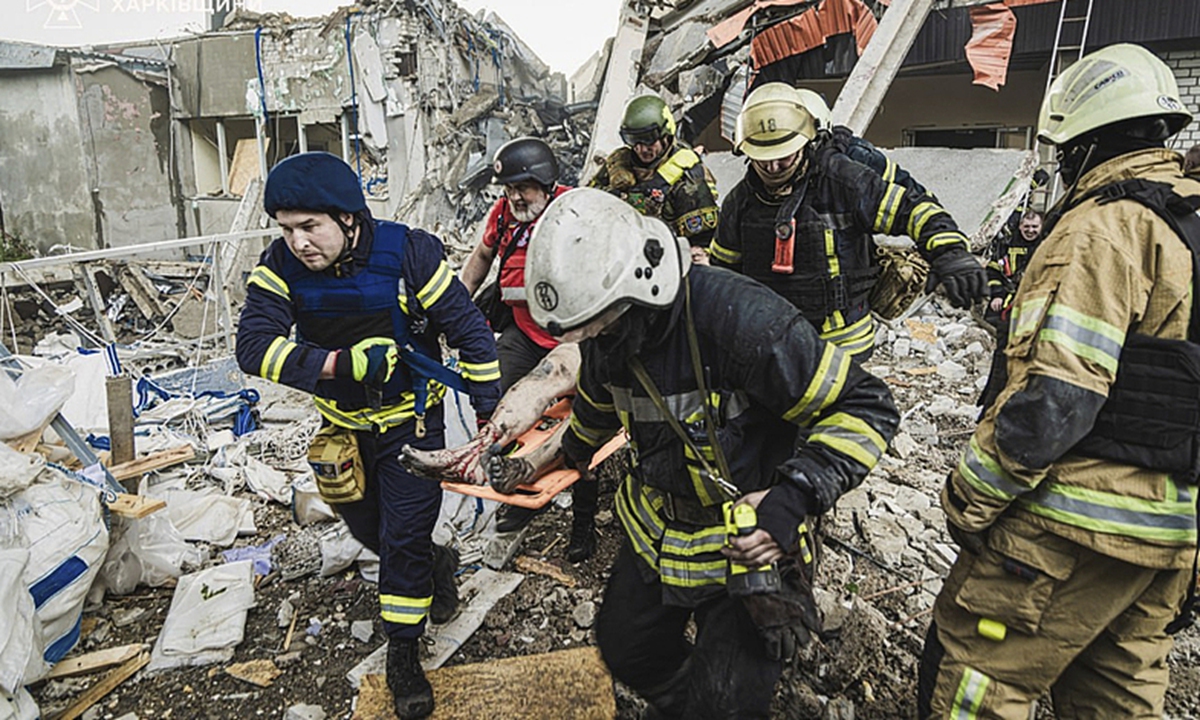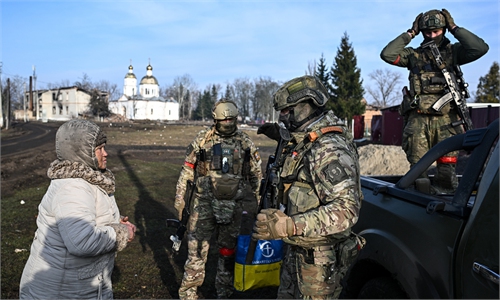
Emergency services personnel carry a body of a victim following a Russian rocket attack in Kharkiv, Ukraine, on June 10, 2025. Photo: VCG
The Russia-Ukraine conflict is facing the risk of further intensification despite recent peace talks, after Ukraine and Russia both launched strikes which caused huge damage to both sides.Kiev and Odesa came under another mass Russian attack in the early hours of Tuesday, according to the Kyiv Independent. Ukrainian President Volodymyr Zelensky said in a post on X (formerly Twitter) on Tuesday that Russia used 315 drones and seven missiles in the latest attack against Ukraine, making it one of the largest attacks on Kiev.
Zelensky accused Moscow in his X post that "Russian missile and Shahed strikes drown out the efforts of the United States and others around the world to force Russia into peace."
Citing authorities, the Kyiv Independent reported that four people were injured in Kiev. Meanwhile, in the southern city of Odesa, two men were killed and at least eight civilians were wounded in the attack. Medical facilities, including a maternity hospital, were damaged in Odesa, according to the media report.
Ahead of Zelensky's remarks, Ukraine's Air Force said on Monday that it intercepted a total of 479 Russian drones and missiles during a record-high wave of strikes overnight, according to the Kyiv Independent. Citing an official statement, the media said Russia launched 499 weapons, including 479 Shahed‑type attack drones and 20 missiles.
Russian's strikes came after Ukraine destroyed a number of Russian bombers in drone attacks on air bases deep inside Russia earlier this month. Moscow said that the attacks were retaliatory measures for Kiev's recent brazen attacks in Russia, according to a Reuters report.
According to Russian ambassador-at-Large of the Russian Foreign Ministry Rodion Miroshnik, more than 100 civilians in Russian regions, including one child, were injured over the past week as a result of Ukrainian strikes, while four people were killed, per a Tass report on Tuesday.
Despite two recent rounds of peace talks between Russia and Ukraine, the significant differences in their negotiating positions, coupled with the battlefield situation, indicate a risk of further escalation, Zhang Hong, a research fellow at the Institute of Russian, Eastern European and Central Asian Studies of the Chinese Academy of Social Sciences, told the Global Times on Tuesday.
This round of mutual strikes has caused immense harm to civilian life, severe damage to infrastructure, and significant political pressure on both governments, said the expert. He noted that more intense fighting between two sides cannot be ruled out in the future as both sides demonstrate an uncompromising stance.
On Tuesday, Russia's Ministry of Defense said that overnight, Russian air defense systems intercepted or destroyed 102 Ukrainian unmanned aerial vehicles (UAVs) across various Russian regions, Tass reported.
Russia's Ministry of Defense said on Monday that Russia's Battlegroup Center has expanded the area of "liberated territories" in Ukraine's Dnepropetrovsk region, after the ministry said a day earlier that Russian troops have reached the western border of the "Donetsk People's Republic" and are advancing in the Dnepropetrovsk region.
Tass said on Tuesday that according to their calculations, since the start of 2025, Russian military personnel have taken control of more than 150 populated areas in Ukraine.
"The current phase is characterized by simultaneous fighting and negotiating," said Zhang, "Russia seeks to break the stalemate in the battlefield, leveraging warfare to advance peace talks."
However, the expert noted that while Russia escalates pressure on Ukraine, Kiev is receiving military support from Europe, making it difficult for Russia to achieve outright victory or its strategic goals, which means the prolonged stalemate and a war of attrition are likely to continue in the near term.




